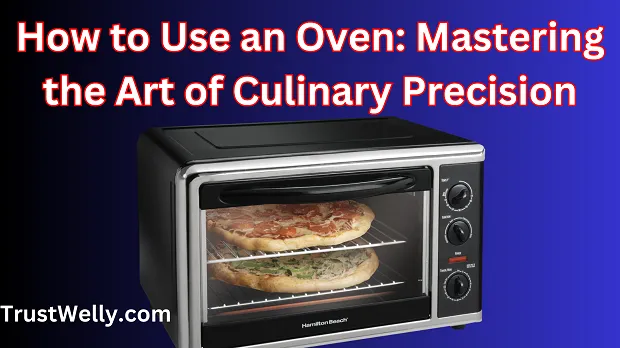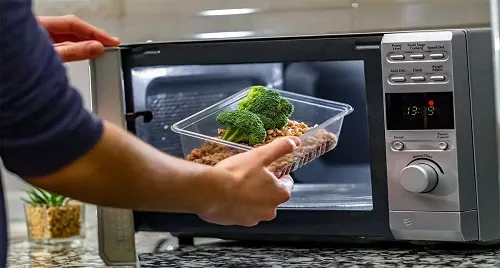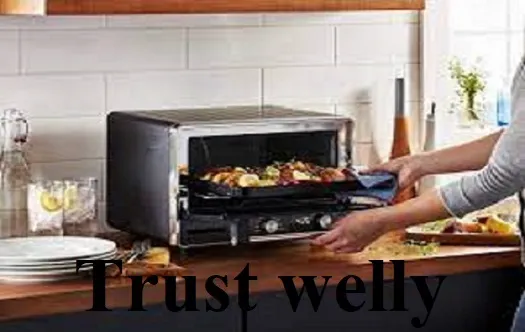Welcome to our comprehensive guide on How to Use an Oven: Mastering the Art of Culinary Precision, Everything You Need To Know About Ovens.

How to Use an Oven | Everything You Need To Know About Ovens
In the culinary realm, the oven stands as a stalwart companion, a versatile tool that transforms raw ingredients into delectable masterpieces. Mastering the use of an oven is akin to unlocking a treasure trove of culinary possibilities. How to Use an Oven
In this comprehensive guide, we delve into the intricacies of oven operation, providing you with a roadmap to elevate your cooking skills. How to Use an Oven, Everything You Need To Know About Ovens
What is a Convection Oven?

A convection oven is a culinary appliance that stands as a beacon of innovation in the world of cooking. Everything You Need To Know About Ovens
What sets it apart from traditional ovens is the incorporation of a fan and exhaust system, which work in tandem to circulate hot air around the food being cooked. This simple yet ingenious addition transforms the convection oven into a powerhouse of precision and efficiency.
Also Read:
- Top 20 Best Microwave Oven
- Top 10 Mobile Phones Under ₹15000 in India
- 10 Best Juicer Mixer Grinders In India
- Latest Top 10 Kitchen Chimneys in India
- 10 Best and Cheapest AC Price Lists in India
The fundamental principle behind a convection oven lies in its ability to ensure an even distribution of heat. The fan facilitates the circulation of hot air, enveloping the food from all sides. This results in uniform cooking, eliminating hot spots that may be present in conventional ovens.
Whether you’re baking delicate pastries or roasting a succulent turkey, the even heat distribution of a convection oven is a game-changer.
One of the notable advantages of a convection oven is its capacity to expedite cooking times. The consistent circulation of hot air enables faster and more efficient cooking. This not only saves time but also preserves the flavors, juices, and nutrients within the food.
From a crispy outer layer on baked goods to perfectly browned roasts, the convection oven delivers culinary excellence with every use.
Additionally, the versatility of a convection oven extends to its ability to handle multiple dishes simultaneously without the fear of flavor transfer. The efficient air circulation ensures that each dish maintains its distinct taste profile, allowing you to prepare elaborate meals with ease.
What is a Microwave Oven?

Microwave Oven, Everything You Need To Know About Ovens
A microwave oven, a ubiquitous and indispensable kitchen appliance, is a technological marvel designed to bring speed and convenience to the realm of cooking. Operating on the principles of electromagnetic waves, it revolutionizes the culinary landscape by offering a rapid and efficient method of heating and cooking various foods. How to Use an Oven
Unlike traditional ovens that rely on external heat sources, a microwave oven generates heat within the food itself. This is achieved through the emission of microwaves, which cause water molecules in the food to vibrate and produce heat.
The result is swift and uniform heating, making the microwave oven an ideal solution for those seeking culinary efficiency. How to Use an Oven
The primary strength of a microwave oven lies in its ability to expedite cooking times. Whether you’re reheating leftovers, defrosting frozen foods, or preparing quick snacks, the microwave’s speed is unparalleled. In a matter of minutes, dishes are heated to perfection, providing a convenient solution for those with busy lifestyles.
Versatility is another hallmark of the microwave oven. Beyond reheating, it excels in tasks such as defrosting frozen items, steaming vegetables, and even cooking certain dishes. The simplicity of its operation makes it an accessible and user-friendly appliance for individuals of all culinary skill levels.
However, it’s important to note that while a microwave oven excels in certain tasks, such as rapid heating, it may not be suitable for cooking techniques that require browning or crisping. Traditional ovens remain the preferred choice for baking and roasting, where an oven’s dry heat is essential for achieving specific textures and flavors.
Understanding Your Oven: How to Use

Types of Ovens
To embark on this culinary journey, it’s imperative to acquaint yourself with the diverse types of ovens available. From conventional gas and electric ovens to convection and steam ovens, each variant brings its unique set of advantages. How to Use an Oven
Understanding the nuances of your specific oven type sets the foundation for precise cooking. How to Use an Oven
Oven Components and Functions
Unlock the full potential of your oven by grasping the functions of its various components. From heating elements and thermostats to timers and convection fans, a comprehensive understanding empowers you to wield your oven with finesse.
Preparing Your Oven
Preheating for Success
Before you dive into the culinary symphony, preheating your oven is non-negotiable. Achieve optimal results by allowing your oven to reach the desired temperature before introducing your culinary creations. This fundamental step ensures even cooking and consistent results. How to Use an Oven
Proper Rack Placement
The placement of racks within your oven is an often-overlooked aspect that can significantly impact the outcome of your dishes. Different recipes demand specific rack placements; mastering this art ensures uniform heat distribution, a critical factor in achieving culinary perfection. How to Use an Oven
Cooking Techniques
Baking Brilliance
For those with a sweet tooth, the allure of baking is undeniable. Unleash your inner pastry chef by exploring the nuances of baking. From cookies to cakes, understanding the principles of baking temperatures, times, and techniques is key to creating confectionery delights that rival those of professional bakeries. Everything You Need To Know About Ovens
Roasting Mastery
Roasting, a technique revered for its ability to enhance flavors, demands precision. Whether it’s succulent meats or vibrant vegetables, mastering the art of roasting involves harnessing the ideal temperature and timing to achieve that coveted golden exterior and juicy interior.
Broiling Brilliance
Broiling adds a distinctive char to your culinary creations. Understanding the nuances of this high-heat cooking method allows you to achieve the perfect sear on meats and impart a delightful crispiness to an array of dishes.
Cleaning and Maintenance
Prolonging Oven Lifespan
To ensure your oven remains a reliable kitchen ally, regular cleaning and maintenance are imperative. From cleaning oven racks to addressing spills promptly, adopting a proactive approach to oven care not only extends its lifespan but also contributes to the hygiene of your culinary haven.
Troubleshooting Tips
Encountering issues with your oven can be a culinary conundrum. This guide equips you with troubleshooting tips, empowering you to address common problems swiftly. From uneven heating to malfunctioning timers, a proactive approach to oven maintenance ensures uninterrupted culinary adventures.
Convection Microwave-A combination of the Two

Convection Microwave: The Fusion of Speed and Culinary Versatility
The convection microwave, a culinary marvel, represents the harmonious fusion of two powerful kitchen appliances – the convection oven and the microwave. This ingenious combination marries the speed and efficiency of a microwave with the versatile cooking capabilities of a convection oven, creating a multifunctional appliance that caters to a spectrum of culinary needs.
At its core, a convection microwave operates on the principles of both microwave technology and convection heating. Like a standard microwave, it employs microwaves to rapidly heat and cook food. However, what sets it apart is the integration of a convection fan and heating element, elevating its functionality.
The microwave component delivers the swiftness for which microwaves are renowned. It excels in tasks such as reheating leftovers, defrosting frozen items, and quickly cooking snacks.
The convection element, on the other hand, introduces dry heat into the equation. This dry heat, circulated by the fan, enables the convection microwave to perform baking, roasting, and even browning – capabilities that traditional microwaves lack.
The versatility of the convection microwave is a game-changer for modern kitchens. Imagine swiftly reheating a pizza slice to piping hot perfection or seamlessly transitioning to baking a batch of cookies without switching appliances. This flexibility makes the convection microwave an invaluable asset for those who seek efficiency without compromising on culinary variety.
Whether you’re a culinary enthusiast with a penchant for experimentation or someone navigating the demands of a busy lifestyle, the convection microwave offers a streamlined solution. It seamlessly combines the rapid heating of a microwave with the culinary prowess of a convection oven, opening up a world of possibilities in the kitchen.
Understanding Temperature Controls and Time Settings: Precision in Culinary Mastery

Mastering the art of cooking extends beyond selecting the finest ingredients; it involves navigating the intricate dance of temperature controls and time settings. Whether you’re an aspiring chef or a home cook aiming for culinary excellence, comprehending these factors is paramount to achieving consistent and delicious results.
Temperature Controls
The Foundation of Precision
In the realm of temperature controls, precision is the bedrock upon which successful cooking rests. Each dish demands a specific temperature range, and understanding this is akin to wielding a culinary compass. Most ovens offer a spectrum of temperatures, typically ranging from 150°F to 500°F (65°C to 260°C).
Conventional vs. Convection Temperatures
Different oven types require nuanced temperature considerations. In a conventional oven, the heat comes from top and bottom heating elements, necessitating slightly higher temperatures. In contrast, a convection oven, with its circulating hot air, often requires lower temperatures and shorter cooking times for the same results.
Preheating: A Crucial Prelude
Before embarking on your culinary journey, preheating your oven is non-negotiable. This initial step ensures that the oven reaches the desired temperature before introducing your ingredients. It lays the foundation for even cooking, a factor critical to achieving gastronomic perfection.
Time Settings
The Chronology of Culinary Alchemy
Time settings in cooking act as the orchestrator of culinary alchemy. Each dish has its unique chronology, and adhering to precise time settings is the key to unlocking flavors and textures.
Baking Times: Precision Personified
For baking enthusiasts, understanding the intricacies of baking times is paramount. Factors such as batter consistency, pan size, and oven temperature converge to dictate how long your creation should linger in the oven. A slight deviation can be the difference between a moist cake and a dry disappointment.
Roasting: The Dance of Timing
Roasting, whether meats or vegetables, involves a delicate dance of timing. Achieving the perfect balance ensures a crispy exterior and succulent interior. Factors such as the cut of meat and desired doneness contribute to the nuanced approach to roasting times.
Broiling: Swift Precision
Broiling is a swift and high-heat cooking method that demands acute attention to time. Whether it’s achieving the ideal sear on a steak or imparting a golden crust to cheesy delights, precision in broiling times is the hallmark of success.
The Symbiosis of Temperature and Time
The magic of culinary mastery happens in the symbiosis of temperature and time. It’s the finesse of knowing when to adjust the temperature slightly or allowing a few extra minutes for perfection. Experience, coupled with a keen understanding of your oven’s nuances, refines this symbiotic relationship.
Conclusion
In the realm of culinary exploration, the oven stands as a gateway to unparalleled gastronomic experiences. Armed with the knowledge gleaned from this guide, you are poised to transcend mere cooking and embark on a culinary odyssey marked by precision, creativity, and mastery.
FAQs: How to Use an Oven, Everything You Need To Know About Ovens
A1: Preheating is crucial for even cooking. It ensures that the oven reaches the desired temperature before placing your ingredients, guaranteeing consistent results and optimal cooking conditions.
A2: Refer to the specific recipe for temperature guidelines. As a general rule, understand the nuances of your oven type (conventional or convection) and adjust accordingly.
A3: Baking typically involves cooking with dry heat in an enclosed space and is common for sweets. Roasting, on the other hand, often involves higher temperatures and is applied to meats and vegetables for a crispy exterior and juicy interior.
A4: Yes, but adjustments may be needed. Convection ovens often require lower temperatures and shorter cooking times. Refer to your appliance’s manual for specific guidelines.
A5: Rely on visual cues, such as golden-brown crusts or clear juices for meats. Additionally, use cooking thermometers to ensure internal temperatures meet recommended levels.
A6: Broiling exposes food to direct heat from above, creating a golden crust. Use it for quick cooking, browning, or finishing touches on dishes like casseroles and gratins.
A7: Regularly clean spills to prevent build-up. For a thorough clean, use oven-specific cleaning products or a mixture of baking soda and vinegar. Follow your oven’s manual for cleaning instructions.
A8: Yes, but consider factors like cooking times and temperatures. Position dishes strategically on racks to ensure even cooking, and rotate them if needed.
A9: Check for obstructions in the oven’s heating elements and, if applicable, recalibrate the temperature settings. If issues persist, consult your oven’s manual or seek professional assistance.
A10: For issues like uneven cooking or inaccurate temperatures, refer to your oven’s troubleshooting guide in the manual. If problems persist, contact the manufacturer or a certified technician.
Thanks for your visit to TrustWelly.com
Please also check our YouTube Channel – Trust Welly – YouTube
